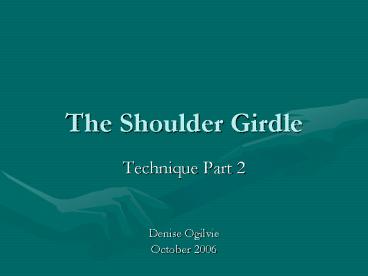The Shoulder Girdle - PowerPoint PPT Presentation
1 / 24
Title:
The Shoulder Girdle
Description:
Should demonstrate all shoulder structures as in AP shoulder ... CR: perpendicular to mid scapula 5cms below coracoid process. 24 x 30 landscape ... – PowerPoint PPT presentation
Number of Views:59
Avg rating:3.0/5.0
Title: The Shoulder Girdle
1
The Shoulder Girdle
- Technique Part 2
- Denise Ogilvie
- October 2006
2
Learning Objectives
- Be able to identify and perform the following
views - AP Clavicle
- Axial Clavicle
- AP Scapula
- Lateral Scapula
- Acromio-clavicular joints
- AP and Lateral Humerus
3
AP Clavicle
- Patient erect or supine
- Centre clavicle to middle of IR or bucky
- Arms resting beside body
- Suspend respiration
- CP perpendicular to midshaft of clavicle
- 24 x 30 cm landscape
4
AP Image Critique
- Should demonstrate all shoulder structures as in
AP shoulder - Distal clavicle seen above scapula with joint
shown clearly
5
Axial Clavicle
- Patient in same position as AP
- Tube angled 30 degrees cephalic
- Move IR upward to centre clavicle to IR
- 18 x 24cm landscape
6
Axial Clavicle Image Critique
- Most of clavicle projected above ribs
- AC joints and SC joints will be seen
7
AP Scapula
- Patient erect-more comfortable
- Can be supine
- Abduct arm as much as possible to bring scapula
away from chest - Top of IR above top of shoulder
- CR perpendicular to mid scapula 5cms below
coracoid process - 24 x 30 landscape
8
AP Scapula Image Critique
- Lateral border of scapula away from chest
- Bony detail of chest
- Acromion process clearly seen as well as inferior
angle of scapula
9
Lateral Scapular (Y)
- This view is the same as lateral shoulder.
- I would have the arm across the abdomen as
apposed to behind the patient-less painful - In cases of severe pain perform lateral in
whatever position the arm presents
10
Lateral Scapula Image Critique
11
Acromio- Clavicular Joints
- Both joints imaged routinely for comparison
- Imaged separately
- Arms relaxed by side
- CR over each AC jt
- Cone down close to joint to stop scatter
- Use 18 x 24 divided into 2 or 24 x 30 divided
into 4 - Out of bucky best
12
Acromio- Clavicular Joints
- Weight bearing views of the AC jts are commonly
performed still at many sites - Current trend is not to perform weight bearing as
it is believed not to show a great deal more - If the trauma is very recent I would look at the
neutral images before any weight bearing views. - Equal weights are attached with a band around the
wrist
13
Acromio- Clavicular Joints
- Do not hold the weights in the hand as this seems
to make the shoulder muscles contract and may
prevent seeing a slight AC jt separation - Each side imaged separately
- Instruct patient to let shoulders relax
14
Acromio- Clavicular Joints Image Critique
-
What not to do. -
Why?
15
Acromio-Clavicular Joints Image Critique
- Reduced exposure-AC jts close to skin surface
- Good coning for scatter reduction
- Clearly marked L R
- Non-weight bearing or weight bearing-4 separate
images
16
AP Humerus
- Erect or supine
- Body position may vary
- Humerus in true AP position abducted slightly
away from body - Hand supinated
- Top of IR 4 cm above head of humerus
- CR perpendicular to humerus, midshaft
17
AP Humerus Image Critique
- Elbow and shoulder on film
- Epicondyles parallel to IR
- Humeral head and greater tubercle in profile
- Even density along humerus
18
Lateral Humerus
- Patient facing IR
- Elbow flexed 90 degrees
- Hand resting on abdomen
- CR midshaft and perpendicular to humerus
- IR 4cm above head of humerus
- If lateral shoulder required rotate body-may need
a wedge filter across lower humerus for even
density
19
Lateral Humerus Alternative
- Almost same image can be obtained with patient in
AP position - Elbow flexed 90 degrees
- Hand supinated against thigh
20
Lateral Humerus Image Critique
- Shoulder and elbow joint seen
- Epicondyles superimposed (lateral)
- Lesser tubercle in profile medially
- Even density of humerus
- McQuillen Martinson p210 good comparison of
latero-medial to medio-lateral laterals
21
Supine Humerus
22
Supine Distal Humerus Lateral
- When patient presents with known or suspected
fracture - IR slid between humerus and body taking care to
move arm as little as possible - If elbow can flex, so epicondyles are lateral,
only if not contraindicated
23
Supine Distal Humerus LateralImage Critique
- Shows distal humerus only
- Epicondyles lateral
- For proximal humerus do a lateral scapula view
24
References
- McQuillen Martinson, Radiographic Image Analysis,
2nd edn - Ballinger, Frank, Merrill's Atlas of Radiographic
Positions Radiologic Procedures 10th edn































